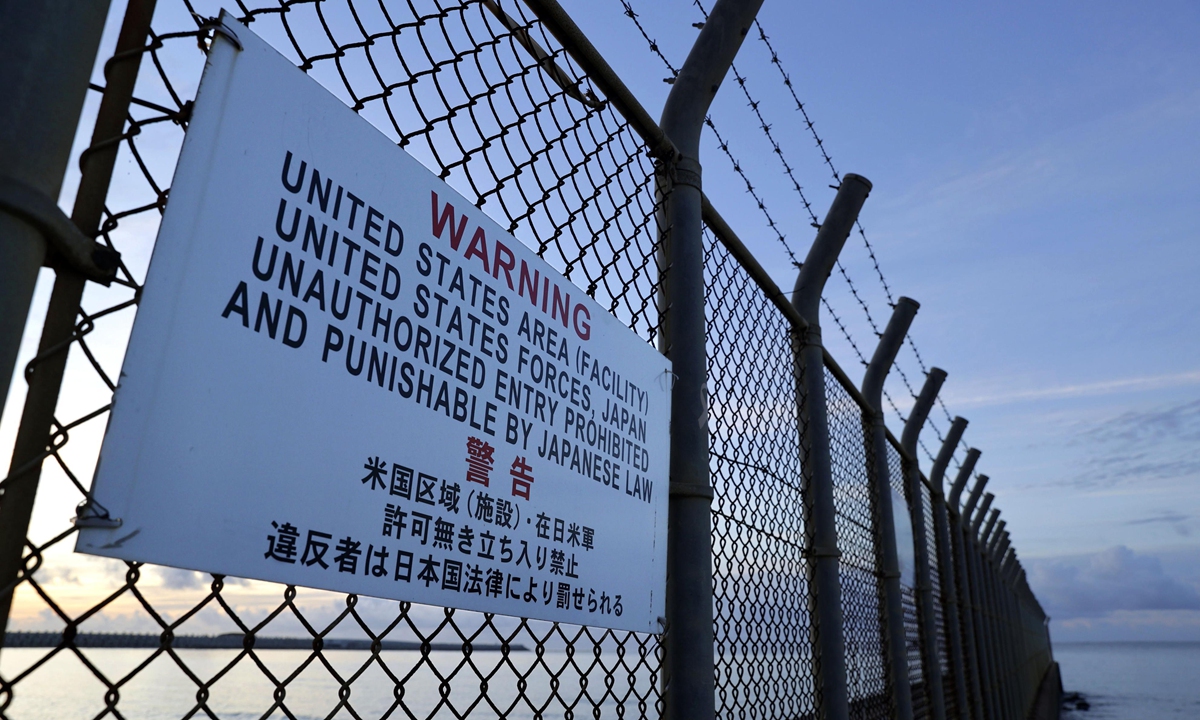
Photo taken on August 24, 2022 shows a warning sign by US troops in Japan placed at the Henoko coastal area of the Okinawa Prefecture. Photo: VCG
The US plans to set up a rapid reaction Marine unit throughout Japan's Okinawa islands within a few years, media reported on Tuesday, one day ahead of the 2023 US-Japan Security Consultative Committee meeting in Washington, DC. Japanese Prime Minister Fumio Kishida also plans to talk with US President Joe Biden on January 13 after concluding his ongoing Europe and UK tour.
A saga of diplomatic and military activities suggests that Tokyo and its allies are likely devising a more detailed and actual-combat strategic deployment against China, but China is always well-prepared to meet the challenge, analysts said.
Citing sources, Kyodo News reported on Monday (ET) that a Marine Littoral Regiment (MLR), will be established as part of a realignment of the Marine Corps in Japan's southwestern island prefecture, which is close to China's Taiwan region.
The US plans to disperse US Marine units throughout Japan's Okinawa islands by 2026, equipping them with missiles and lighter gear to "deter China's military," Reuters reported Tuesday, citing Japan's Yomiuri newspaper.
Chinese Foreign Ministry spokesperson Wang Wenbin called on Japan and the US to ensure their military cooperation does not harm the interests of third parties or regional peace and stability.
We hope that relevant countries will respect the security concerns of countries in the region and do more to enhance mutual trust among countries as well as regional peace and stability, Wang said at a routine press conference on Tuesday.
Japanese media said the plan is expected to be discussed at the 2023 US-Japan Security Consultative Committee, which also known as "2+2" security talks between foreign and defense ministers. Japanese Foreign Minister Yoshimasa Hayashi, Defense Minister Yasukazu Hamada, and their US counterparts Antony Blinken and Lloyd Austin are expected to attend the planned in-person meeting.
Hyping China's "increasing assertiveness," along with North Korea's missile testing and Russia-Ukraine conflict, Japanese media said that Tokyo hopes to articulate plans to acquire "enemy base strike" capability at the upcoming "2+2" security talks, with the Taiwan question to be discussed.
Zhu Qingxiu, a Japanese studies researcher with the Chinese Academy of Social Sciences, told the Global Times on Tuesday the possible discussion of MLR deployment at the "2+2" security talk indicates that the US and Japan may come up with more tactical deployments that focus on details and actual-combat level in the future.
For instance, issues of resource allocation, a unified command structure, Japan's use of US military bases, and coordination of intelligence and reconnaissance are all likely to feature in the "2+2" security talks, Zhu noted.
Japan's role in a possible conflict in the Taiwan Straits is likely to be discussed during the "2+2" meeting. In a recent interview with the Financial Times, top US Marine Corps general in Japan James Bierman said that US and Japanese armed forces are integrating their command structure and scaling up combined operations.
Bierman told the Financial Times that in the recent joint drills, the Marines for the first time set up bilateral ground tactical co-ordination centers. Besides, specific Japanese military units have been designated as part of the "stand-in force" alongside US forces. Reuters said the Marines plan to cut aircraft numbers and dump most of cannon artillery and heavy amour in favor of smaller "dispersed" forces.
The US plans to push Japan to the front line of the conflict so Japan takes the brunt of the attack so China could not wipe out US forces, Zhu said, noting this is also why US armed forces in the Western Pacific are showing a trend of dispersed deployments as Japan's national security strategy shifts to its southwestern islands.
In fact, in Japan's three key defense documents revised in December, the Kishida administration pledged to strengthen Self-Defense Forces units in its southwestern islands, describing China as its "greatest strategic challenge."
As part of efforts to develop its counterstrike capabilities, Kishida's government has earmarked about $1.58 billion to procure US long-range Tomahawk cruise missiles in the draft budget for fiscal 2023 from April, Japanese media said.
China is always well-prepared and observing Tokyo's and Washington's moves, Zhu said. "Although Japan is trying to put pressure strategically on China by deploying forces near the Taiwan region, it cannot change the fact that the People's Liberation Army (PLA) are much stronger than Japan's [forces] in the region."
Developing "counterstrike capabilities" cannot form a deterrent to China, but will only be a sheer waste of Japanese taxpayers' money, analysts said.

